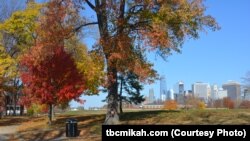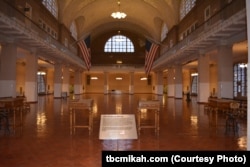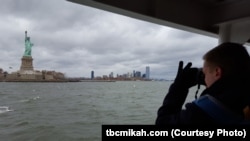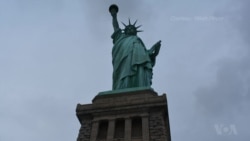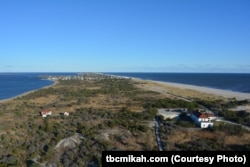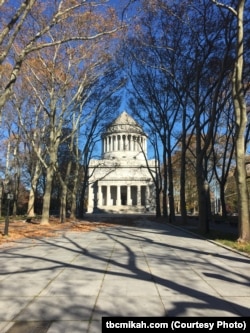As national parks traveler Mikah Meyer walked through the now-quiet halls on Ellis Island, he couldn’t stop thinking of his own family and how they had traveled to America many years ago.
From 1892 to 1954, more than 12 million immigrants were processed in its bustling and often chaotic rooms, making it the nation's busiest immigrant inspection station during those years.
“I was just imagining my great-grandparents coming to this country so that I could be here today and visit all these national park sites,” he said. “It was really incredible.”
Those thoughts took on even deeper meaning when during his tour, a park ranger asked for a volunteer to do a little role-playing. Mikah stepped up.
“She slammed her hands on the desk and said: ‘Okay, what's your name? And why do you want to come into the country?’ and she acted as if I was an immigrant,” Mikah described. “Then she pulled up their little stock photo and she said, ‘Okay, you are coming here from Bremen, Germany,’ which is actually where my family is from and where they came from to come to the states. So it was this really amazing moment,” he said.
Beacon of Liberty
Moments before, Mikah, who’s on a mission to visit all of the more than 400 sites within the National Park Service, had stepped off a ferry after visiting the Statue of Liberty, another iconic site in New York Harbor off the southern tip of Manhattan.
Lady Liberty was a gift of friendship from France to the United States, and is still regarded as one of the most universal symbols of democracy. Erected in 1886, the statue was the first thing millions of immigrants saw as they sailed into New York Harbor.
“There's a few sites on my trip that have barely had any visitors at them… and then there's some sites like the Statue of Liberty where it's like a melee to try to get into this place,” Mikah said. “It’s an incredibly, incredibly popular attraction, especially for international visitors.
“Around me in the line I heard people speaking all these different languages,” he added. “It was very apparent that the Statue of Liberty is something that speaks to people around the world—whether that's just for tourist reasons or because their family came to America.”
Taking small bites out of the Big Apple
The iconic sites were among the dozen national park places Mikah visited during his recent trip to—and near—New York City.
“New York is so exciting because there's so much going on, and to be there and experiencing the way that these national park sites help to make New York what it is today; it was all just fascinating,” he said. His experiences ranged from the beautiful to the historic; all places that help tell America’s story.
Standing at the top of a lighthouse, he described the breathtaking land and seascapes of Fire Island National Seashore as “a very thin sandbar, barely large enough to sustain houses and a few roads, but miles and miles of shoreline for those seeking an escape from New York City.”
Among the historic sites he visited was Castle Clinton National Monument, which is currently a ticket booth for the Statue of Liberty Tours. “Most people don't realize it’s actually a national park site,” Mikah said. “It’s an old historic fort that was used in the War of 1812 to help defend Manhattan.”
Federal Hall, located on Wall Street, is where George Washington took the oath of office. It was home to the first Congress, Supreme Court, and Executive Branch offices. Now it serves as a museum and memorial to America’s first President.
“They basically say Federal Hall is where America became America,” Mikah said.
And Governors Island National Monument is a former military base that’s now a scenic historic site a short ferry ride from downtown Manhattan. “I can't believe it hasn't been developed yet because it's just a free 10-minute ferry ride south of the Lower Manhattan tip and it kind of looks like a small middle-American suburban town.”
Mikah also got to visit the tomb of Ulysses S. Grant, who led the Union Army to victory in the American Civil War, and then, as president, strove to heal a divided nation and empower all its citizens.
“They said at the time of his funeral he had over a million people lining the streets of Manhattan,” Mikah said, “which at the time was an insane number.”
At Hamilton Grange National Memorial, which preserves the home of founding father Alexander Hamilton, Mikah got to spend time with the actor who plays George Washington in the hugely successful Broadway musical Hamilton.
"The cast member Nicholas Christopher stood there right in front of [the portrait of] George Washington and I took his picture," Mikah said. “So it was fun for us to meet, but then also to go to this site and to see him learn the history of the Hamilton gravesite and say, ‘Oh, that makes me think about this part of the show differently.'”
Mikah says New York was truly representative of the depth and breadth of just how much of America is preserved and protected by the U.S. National Park Service.
“For me, as an American who went through the public school system and learned about American history, it is easier to retain knowledge and to understand this history when you're physically standing there,” he said. “So I think being in these sites makes it a little easier than just reading it in a textbook.”
To learn more about his time in New York and the many other sites he visited, Mikah invites you to visit him on his website, Facebook and Instagram.




